
For two hours, we drove through the winding road up and down the mountain ranges, past endless rice fields and small settlements, until we reached the first houses of Kuki. It was mid-April, hot, dusty and not a soul to be seen. No matter where we looked, there was a striking amount of firewood piled up everywhere. We had never seen so much firewood in our life. In between the firewood, we repeatedly spotted single, or several stone pillars standing side by side.
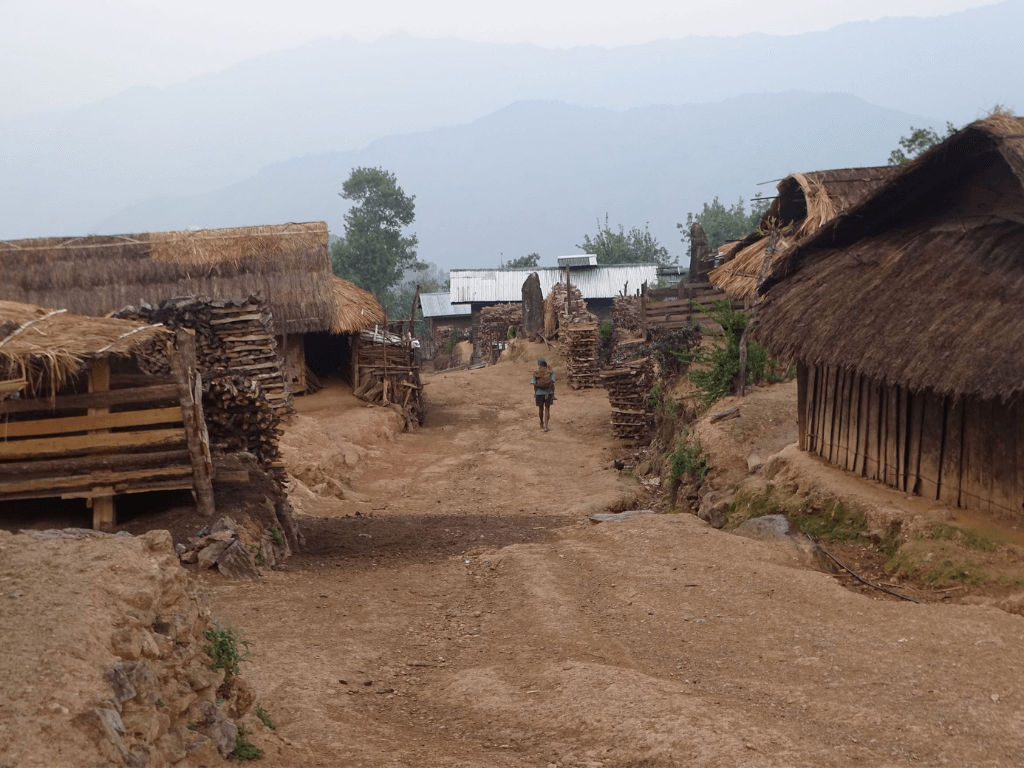
We could not imagine that these roughly shaped slate pillars were inscribed and they represented the largest local history book we had ever seen. We stopped in front of a new two-story house, centrally located, just above the local well, where we were going to spend the night. They used pinewood all around, with an open wrap-around balcony and bright, spacious rooms. Each room had a wide bed, soft mattresses, thick blankets, and pillows. It was a house where we did not feel like rushing our stay.
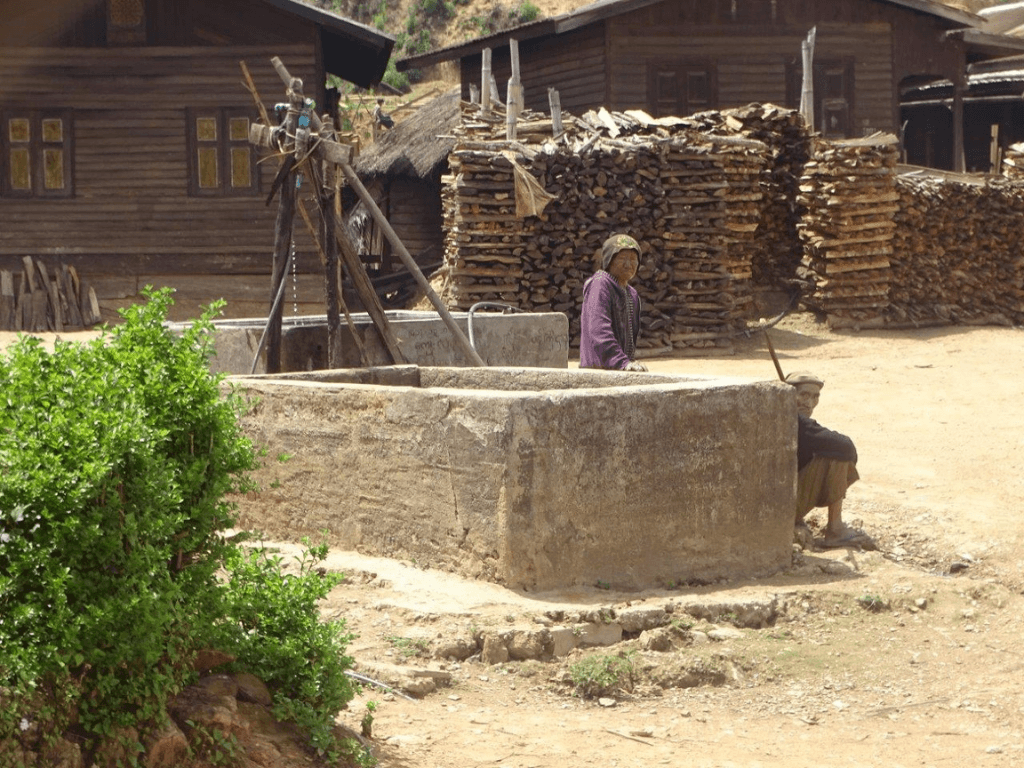
In the late afternoon, we set out to explore the place. Just across the road, an elderly man sat in the sun, splitting bamboo into thin strips with his knife and weaving beautiful baskets. We found out that his name was Sisar, 75 years old, who sits in front of the house almost every day to weave baskets. The men in his family had been doing this for generations. As a boy, he wanted to work for the government, but he had to learn Burmese, which was only possible in Htamanti. When he came across a nurse and her husband from Htamanti who offered him a place to live, he thought his path was set. He was 16 when he left his parents' home and set off towards his dream. They walked for four days, uphill and downhill, through dense jungle, until they finally arrived in Htamanti. After a year, his mother had sent his brother to bring him home to work in the fields. He got married at 19, but a year later the Naga army came to Kuki and took him away. For two and a half years, he had to serve. They fought the Myanmar army to gain more independence, lost the battle and had to surrender. He has 6 children and 20 grandchildren. The children are all still here in the village, working in the fields or for the government. His wife died eleven years ago. She could not get over the fact that a storm destroyed all their rice fields, went crazy, got sick, and died. He himself is quite content with his life, healthy both mentally and physically, and with a good sense of humor. When pointed out about his bad smoking habits, he mischievously pointed at the pretty girl adorning the packet as his reasoning.
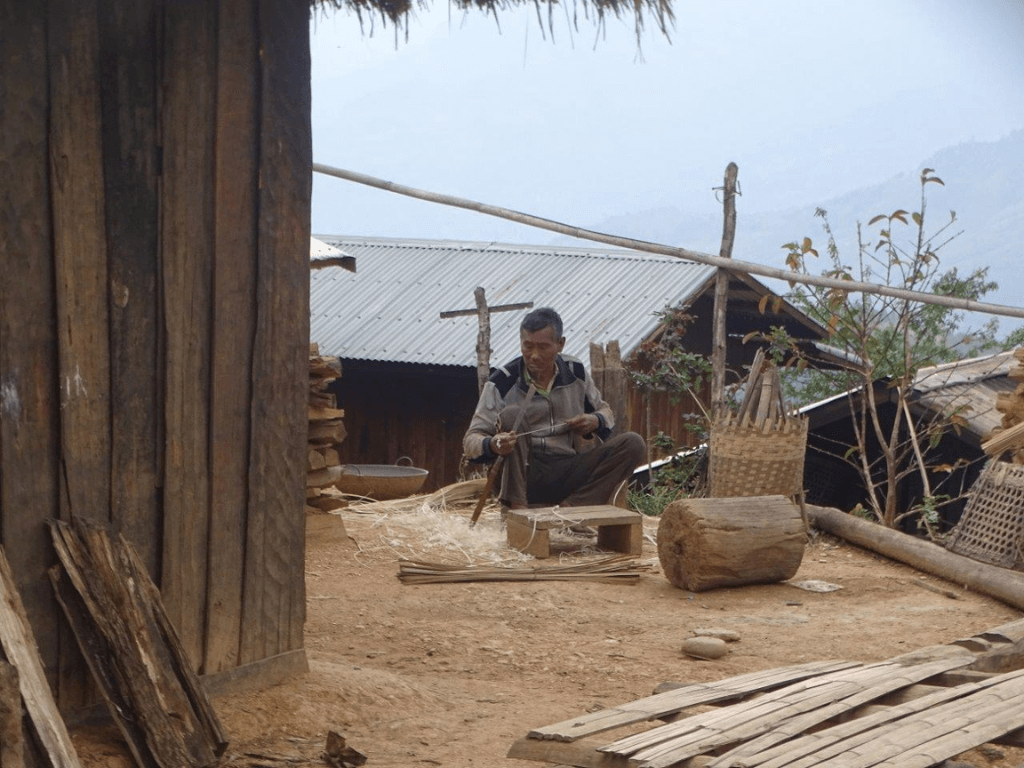
On our tour, we saw magnificent, very solid wooden houses made of long overlapping pine boards. Walls made out of stone that were waist high bordered the properties. The strong wooden doors at the front of the houses, some carved, were impressive. Every now and then, we marveled at wooden boards decorated from top to bottom with roughly carved buffalo heads. Most of the houses had no windows, but if they did, they were rather small and closed by shutters.
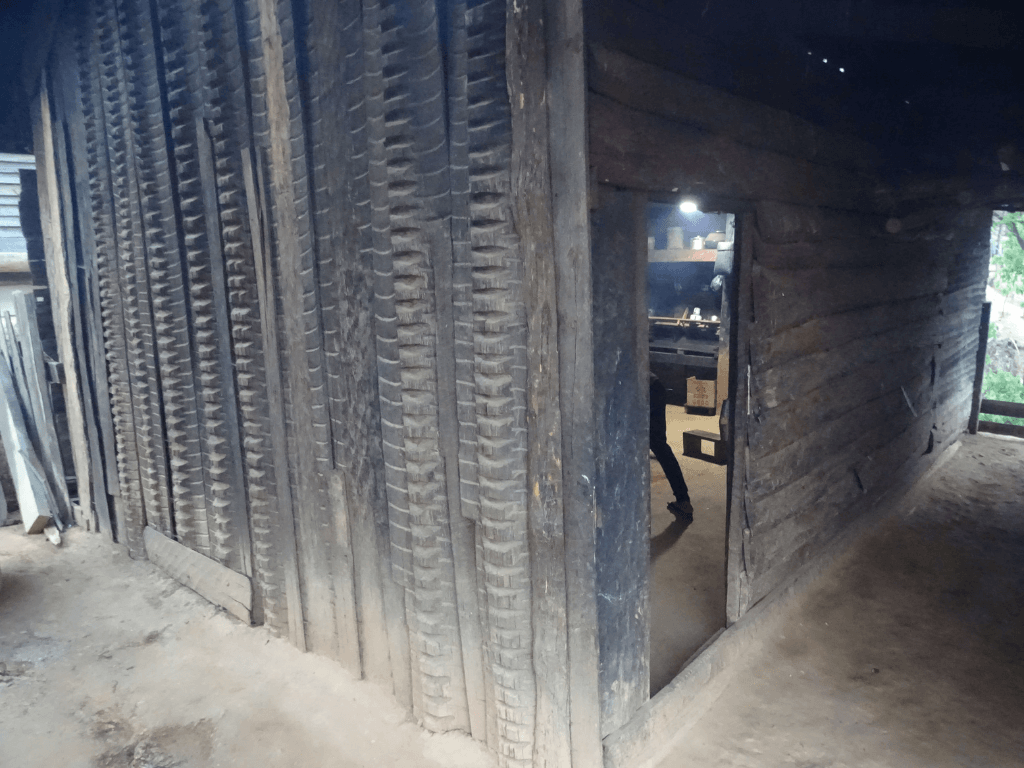
They still used traditionally covered straw roofing in many houses, halved bamboo canes served as rain gutters. The interior was gloomy, lit only by the fire and the light that fell through the cracks. However, it was very spacious and homely. As clean as after a thorough spring-cleaning, even the clay floor. In the middle of the room, there was a fireplace, and a rack for smoking meat above it. There were also 10 cm high wooden stools to sit on around the fireplace. On the wall at the back, there was a shelf for pots, plates, cups and glasses, and next the shelf laid a built-in cupboard with multi-colored doors.
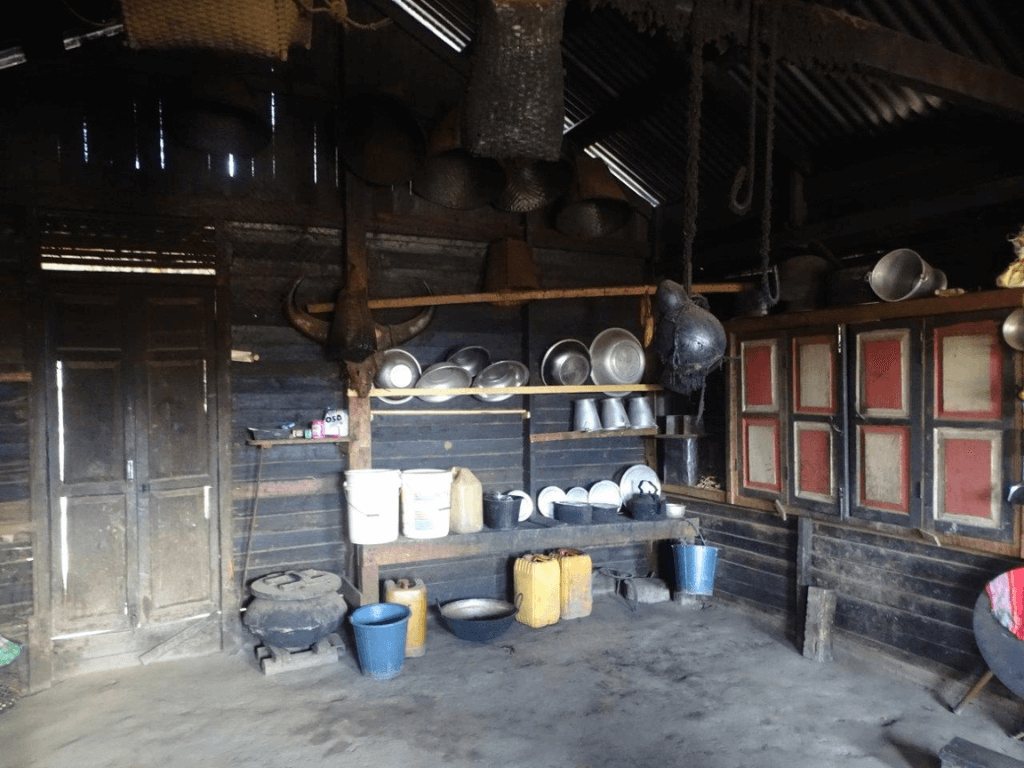
Only older women over 70 still had tattoos on their faces, those on their chins indicated tribal affiliation; some women also had tattoos on their arms and legs. The neck jewelry and the large ear holes hanging down from wearing heavy rings were also noticeable. In everyday life, however, the women only wore light ear jewelry, either silver colored discs or cork-sized pieces of wood.
The women were generally very shy and did not want us to take their photograph. Two older women invited us for a cup of rice wine. The guide and I sat in front of the small hut and tried to talk to the women. This was not easy, as the women did not speak Burmese; they spoke in a Naga dialect that even the guide did not understand. Until mid-2005, it was not possible for the Nagas to learn Burmese, not even in Layshi.
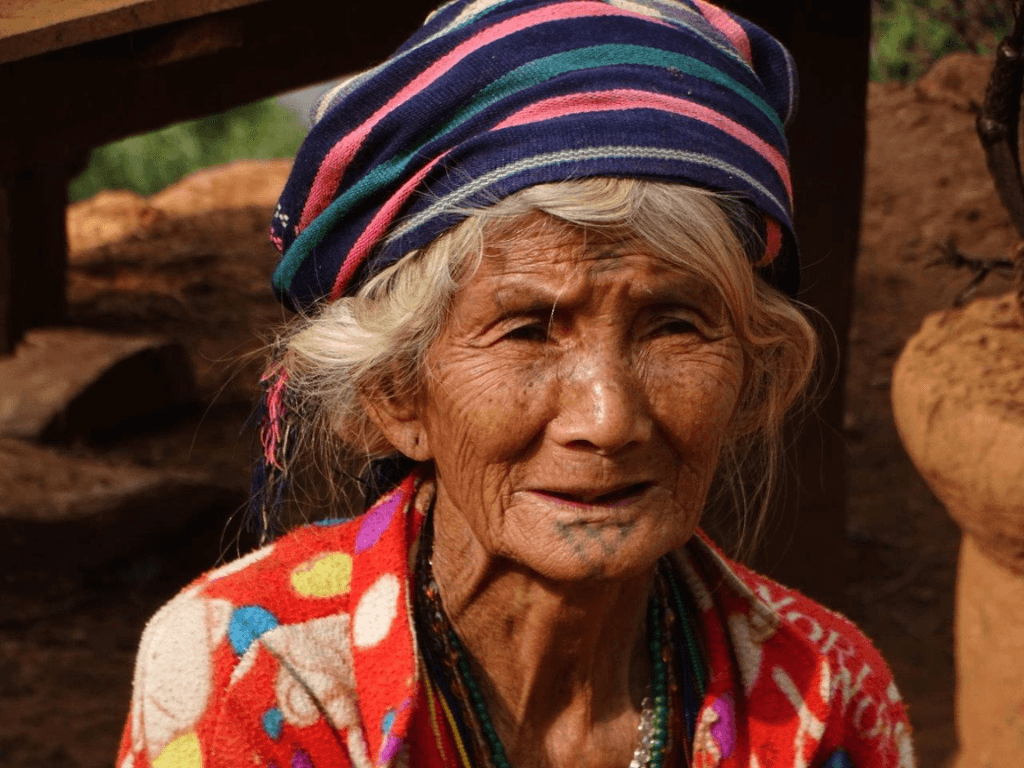
On our tour, we also learned more about the inscribed stone slabs that stood throughout the village. An older man told us how they carried the heavy stone slabs into the village. All the men of the village, young and old, had to help to pull the heavy stone slabs into the village with long Ratan ropes. Villagers did not have permission to touch the stone slabs; only the king of the village had the authority to do so. Another man heard that in the past the very brave young men used to slide down the mountain on the stone slabs. That must have been quite a spectacle. On the stone slabs, they had written down how many buffaloes, pigs, and chickens someone had donated for a feast, other stone tablets commemorate the father, the village chief, the village king, or a very special event.
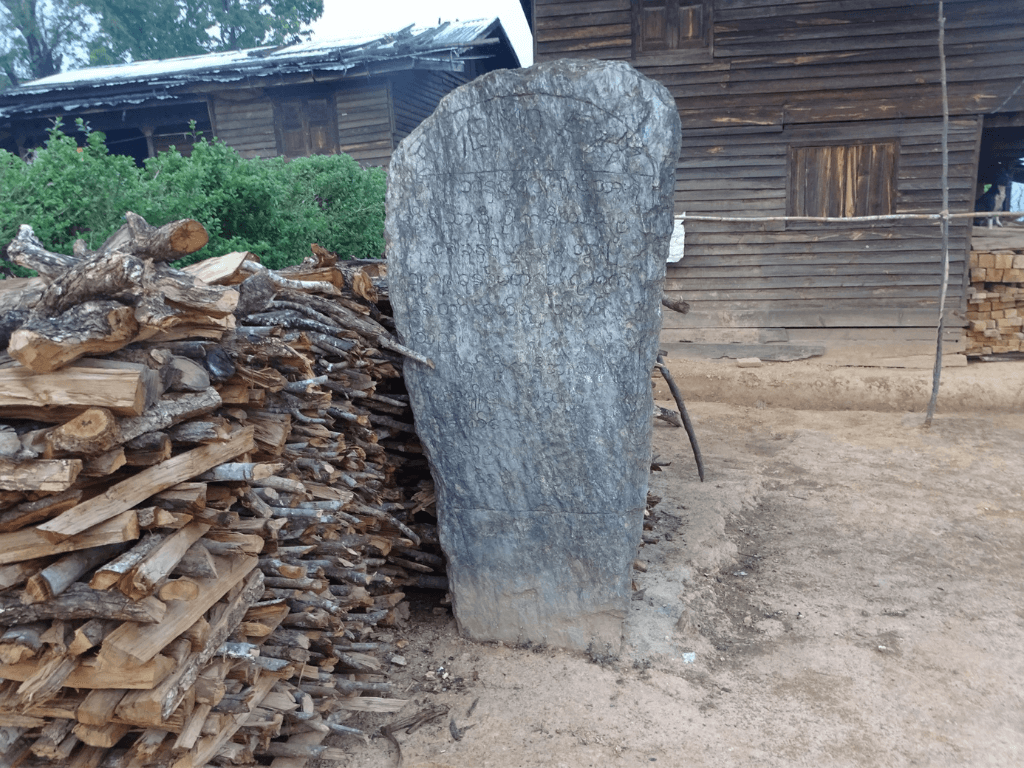
After our journey through the history of Kuki, we stood at the top of the hillside. Directly in front of us was the new church, a few meters further along the road to the left was the Naga Museum, and in front of it five ornate wooden pillars rose into the sky. This was where the village youth also gathered in the late afternoon. Not because of the museum, which was closed anyway, or the fantastic view of Kuki and the Naga Mountains, but because this was the only place in the village where they could use the internet.
Old Gon Kan Lon is located deep in the Naga Mountains, above the Naw Win River, at an altitude of 1879 meters. The narrow road that winds through the Naga Mountains from Layshi to Sumra cuts the village in half. To the right, up the mountainside is the old part of Old Gon Kan Lon and to the left, down the valley we could see the newer huts and the church, which rose above a small hill. From the village we had a fantastic view of the Naga Mountains and the Mole, which dominated the scenery. To the right of the mountain, the rooftops of Sumra shimmered in the far distance. The first Nagas settled here before the Second World War. Today the village has about 190 houses and about 1,000 inhabitants who live from rice cultivation and hunting. After we had set up our nights’ lodging in the school, the men guided us through the village. The tour took us up to the old part of the village first, where we met friendly but also reserved people. The people there had certainly not seen many tourists yet, and we were supposed to be the first ones to spend the night there.
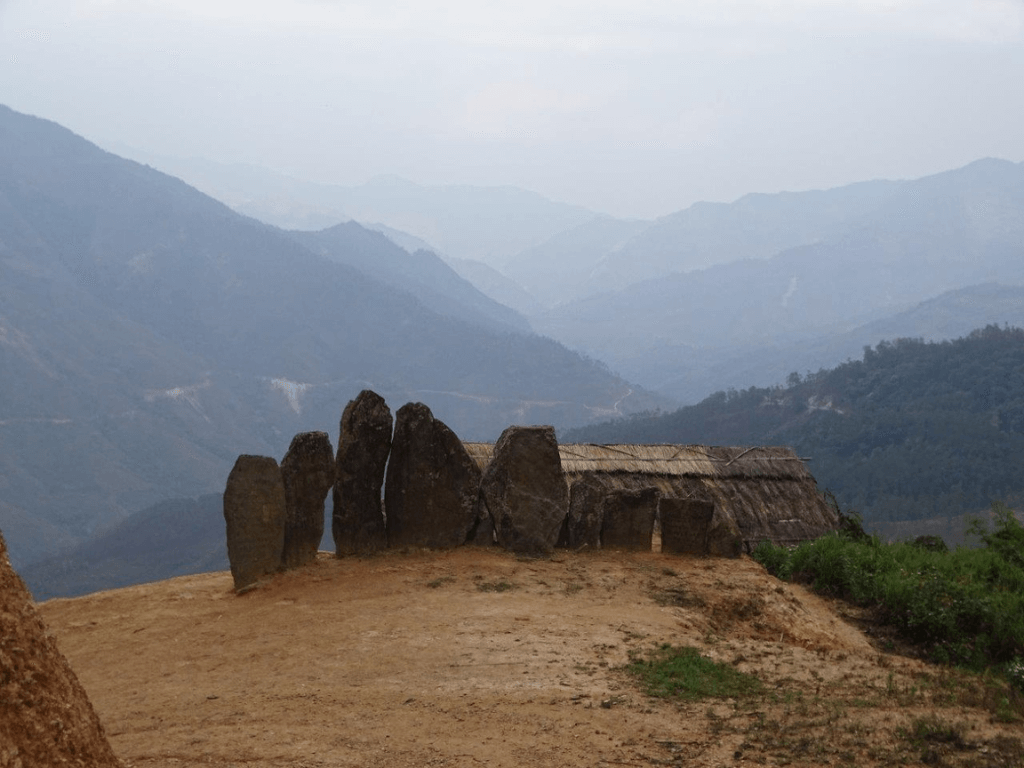
On a small plateau, we saw several memorial stones. Up to four generations ago, they told us that they displayed their trophies, heads of the enemies, on that square. Next to the square, in a simple wooden hut covered with straw, lived a man over 80 years old who has never left that place all his life. As the firstborn of the "Village King," it was his duty to uphold the tradition and he would pass this task on to his firstborn. Born in Kuki, 81 years old, Sro Bo, who was still quite spry for his age, looked at us curiously. His small stocky figure stood at the open door, his dull, somewhat milky eyes wide open. The children, who lived in a larger house right next to the small hut, approached and formed a semicircle with us around the village king.
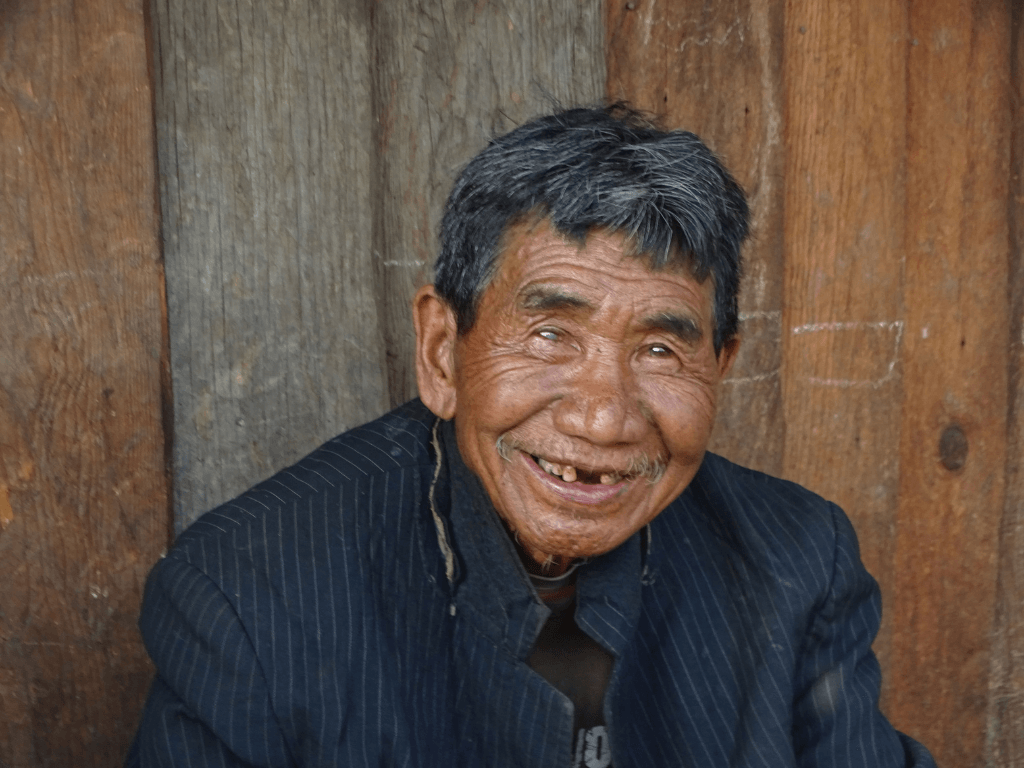
Sro Bo was still a little boy when his parents died. He did not know exactly how old he was then. He assumed he was about 6 years old, but his palm, which was indicating his height then, stood about 80 cm above the ground. He was not the firstborn, but since his older brother passed away, it was his task to carry on the tradition and so the little boy became the new village king of Old Gon Kan Lon. Pa De, who lives nearby, remembers this time very well. She also remembers how his parents died and that he was still very young, too young to support himself. Therefore, they arranged a marriage at short notice with an older girl so that he would have someone to take care of him. One of the most important tasks of the village king was to determine the start of the rice-planting season, which we experienced the next day.
The village king also had the power to predict the future. We all silently watched in suspense as he placed a short round stick diagonally against a piece of hardwood. He pressed the other end firmly against the ground with his foot, passed a bamboo strip under the round wood, pulled both ends upwards until the bamboo strip laid firmly against the round wood and then moved the bamboo strip up and down continuously as fast as he could until it tore. The process was certainly not easy; the effort was clearly visible on the village kings’ face. After looking at the result of his ritual for some time, he looked at me and said that my journey would go smoothly without incident and that I would arrive safely back in Yangon. Feeling relieved, we said goodbye to the village king and continued our tour.
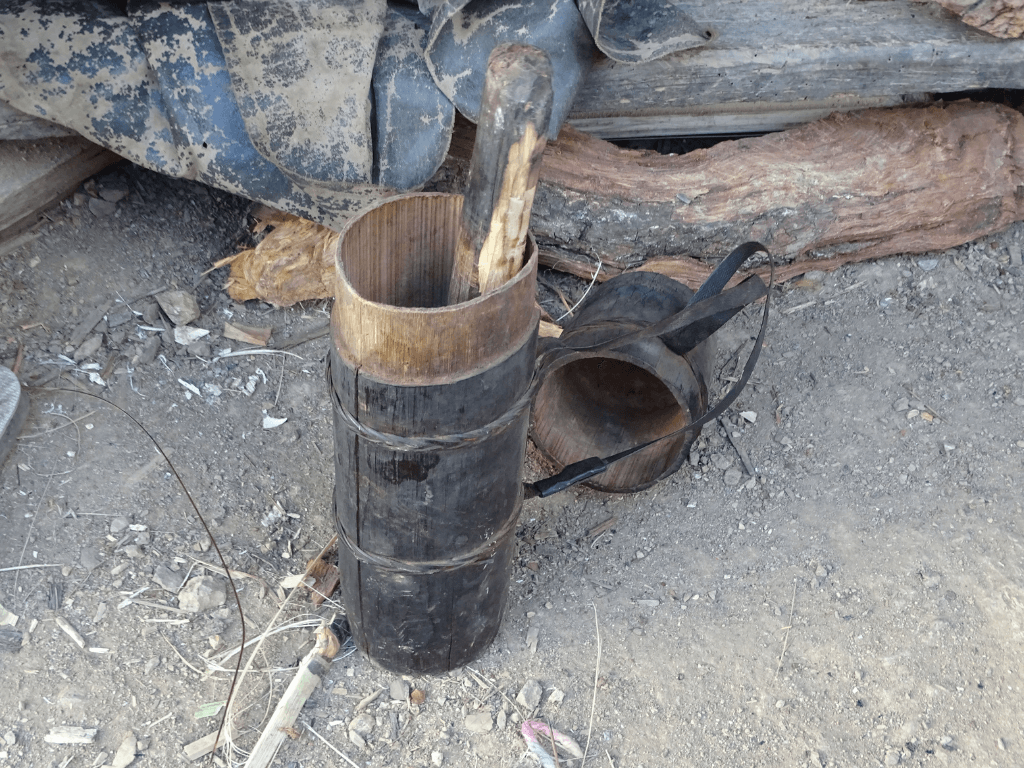
Pa De did not know her age either, but the village king was just born when she gave birth to her first child. This meant that she was almost 100 years old. The villagers say she has already passed 100, and she clearly remembers the time when they had to hide from the Japanese soldiers in the jungle. They came into the villages looking for food and killed all the animals. She did not know how old she was when she got married, but her hair was already down to her shoulders. She did not agree at all with her parents' choice and got angry. Not because he was not good looking, but because she did not love him. She would have liked to marry someone she loved, someone who was not only good looking but also had big fields. Pa De had five brothers and three sisters, all of whom died before she got married. After marriage, she lived with her husband and his family. Only when she had her first child, they moved out and had their own house. She had "only" nine children, three died in early childhood. The large, elongated ear holes indicated that she used to wear heavy earrings. Following an old tradition, girls had their ears pierced and wore earrings; otherwise, they could not get married. The sun was already disappearing behind the mountains when we said goodbye to Pa De.
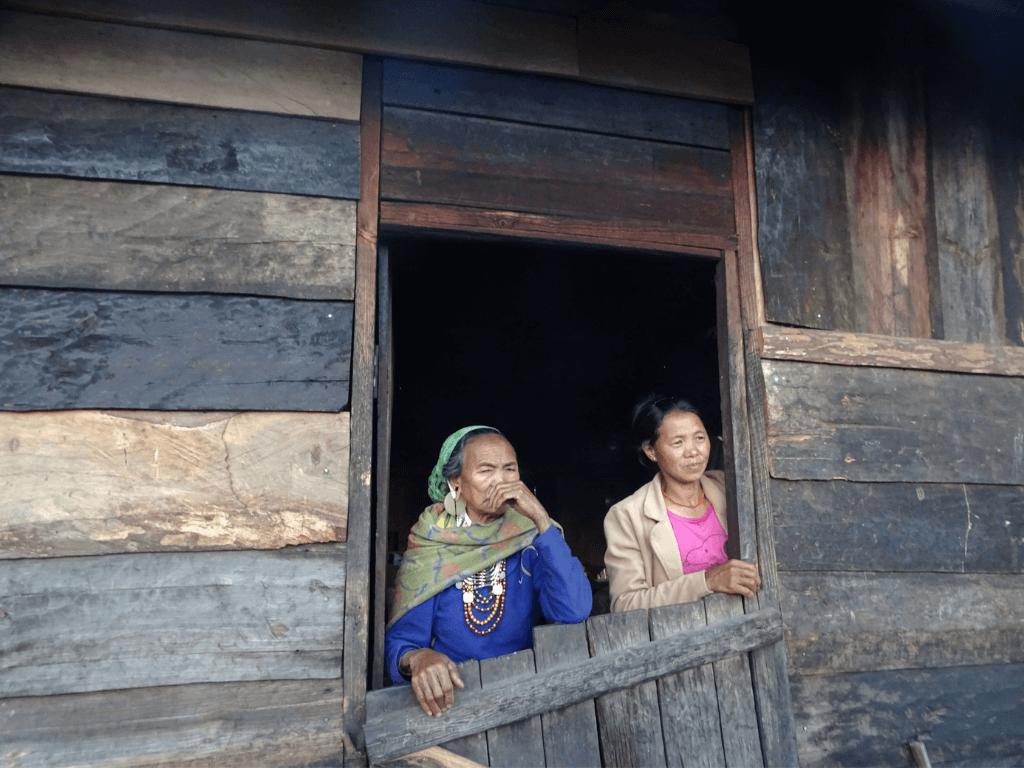
The wind whistled through the cracks in the boards all night. One could not have a peaceful sleep there. Therefore, I was glad when the restless night ended and with the first light of daybreak, I was on my feet. It was cold, the icy wind shrilled around our ears and dark clouds promised rain.
Fortunately, after breakfast it cleared up a bit. Due to the ideal hiking weather, we decided to walk all the way to Pundere (1728 m), which was on the other side of the valley. Around 8:30, we set off with a local guide. The pleasant path lead us steadily downhill, through mixed forest: deciduous trees, pines, and rhododendrons. Every now and then, an elderly woman would flit past us and swung herself down into the valley with the help of a long bamboo pole. We swore to try that sometime. It would have cut our walk in half, but we were in no hurry and enjoyed nature to the fullest.
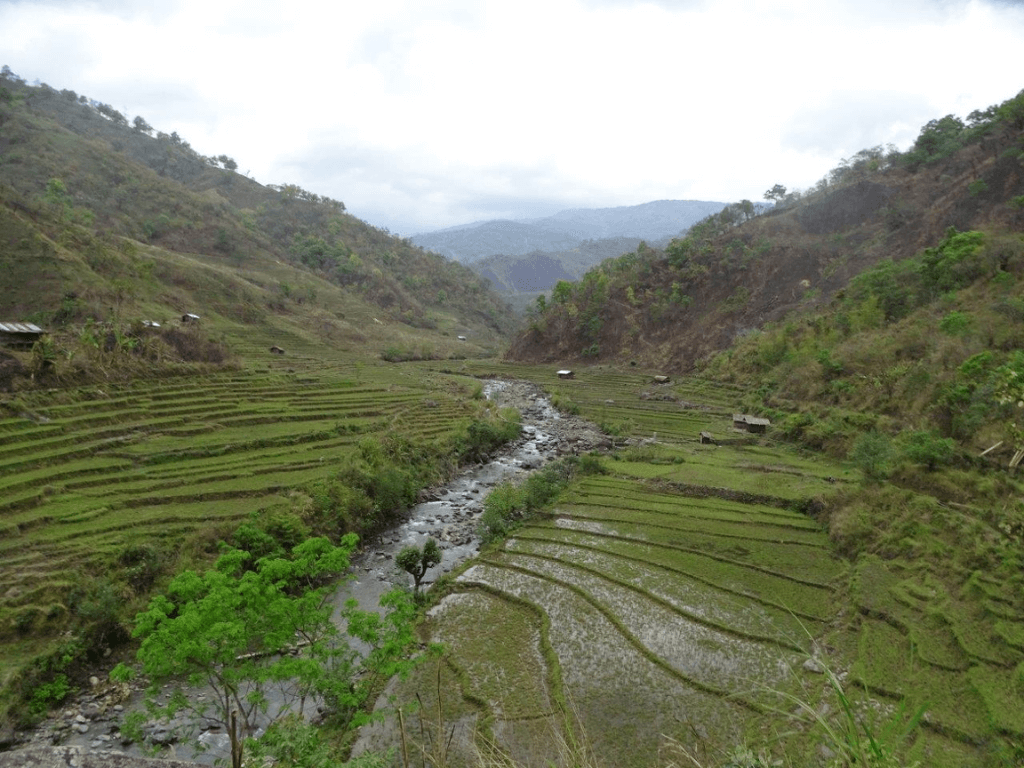
After a little more than two hours, we reached the river, which meandered through the valley past rice terraces. We stood there for a while and took in the breathtaking view. There was a small water mill and a suspension bridge that traversed the river. A small herd of water buffaloes leisurely bathing and Nagas planting rice everywhere completed the picturesque scenery.
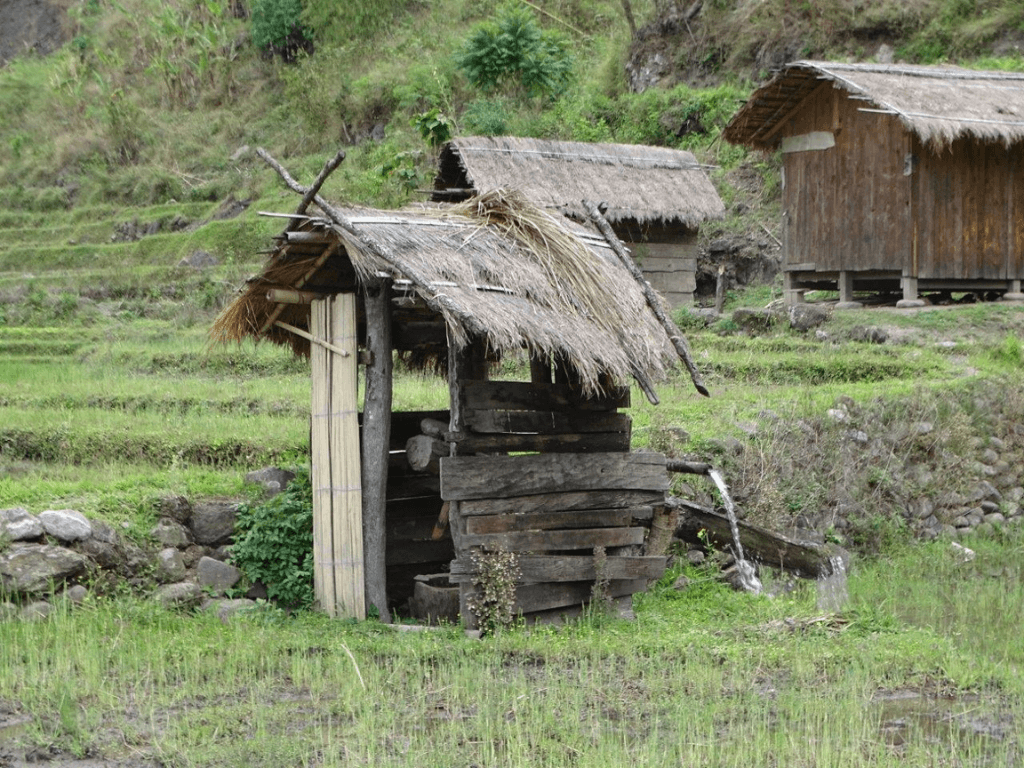
After letting the atmosphere take effect on us, we continued our ascent, which was long, but not steep. We stopped repeatedly to enjoy the view down the valley and the mountains behind. After two and a half hours, the first houses of Pundere appeared. Here the vehicle awaited us and brought us to Sumra (1889 m).
